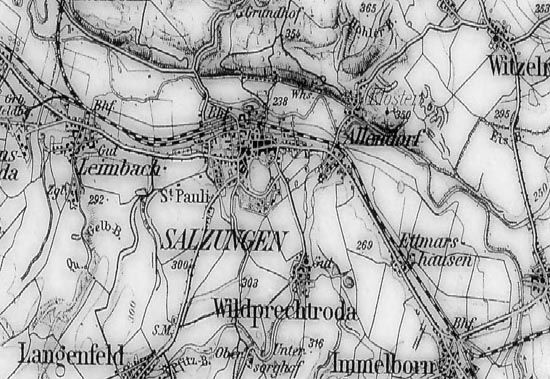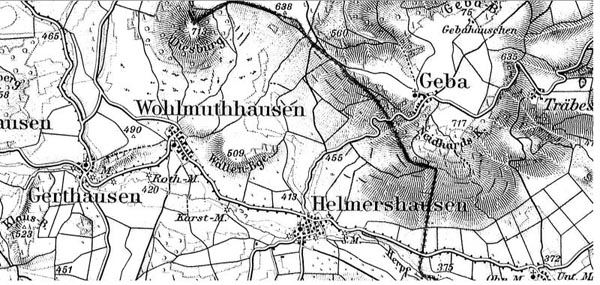 My last article discussed how to use Meyers Orts (a German gazetteer) and the German Topographical Maps at Ancestry.com. These finding aids were crucial in resolving conflicting birth information for one of my ancestral families.
My last article discussed how to use Meyers Orts (a German gazetteer) and the German Topographical Maps at Ancestry.com. These finding aids were crucial in resolving conflicting birth information for one of my ancestral families.
American sources provided the names of several German locations relative to the origins of my Trautvetter family, who immigrated to the United States in the 1850s. The problem was that the places appeared to be inconsistent with each other. Before I moved to the conclusion that the entire family was crazy and trying to “hide” their origins, I dug a little deeper. Here’s what I had:
- According to his 1930 death certificate, George Trautvetter was born in 1842 in Wolmuthausen, Germany.Â
- That same document indicated his father, John George, was born in Wildbrechtroda, but his 1855 declaration of intent indicates he was born in Salsungen.Â
- The 1930 death certificate said that his mother, Sophia, was born in Wolmutahausen[sic], while her death record gives the birthplace of Helmershausen.
I don’t have any other U.S. records that provide places of birth for these immigrant family members. In fact, I was fortunate to have the locations I did have.
Using Maps and GazetteersÂ
Maps of the relevant areas are always important and may explain away apparent inconsistencies. It is possible that the locations provided are actually fairly close together and not as conflicting as originally thought. Instead of providing the actual birth place, one of the records may actually have given the name of a nearby larger village. It is also important to remember that the information obtained so far is secondary and could easily be completely or partially incorrect. Â
Â
Finding foreign villages is not always easy, even with the Internet and a variety of online finding aids readily available. If you’re lucky, the provided spelling is close enough to being correct that finding the village is not difficult.
There are times where it is not so easy. The village may no longer be in existence or may have been renamed. The place may not be “where you think it should be” or may now be located in a different country or political region.
Incorrect spellings are one of the most common handicaps researchers face in locating places. One of the most common reasons for these misspellings is the writer’s attempt to Anglicize a non-English location.
Â
Searching for names or places that are in a foreign language is somewhat easier when one has an approximate idea of how the names or places would have been pronounced by the native speaker. Learning more about native pronunciations may be helpful.
Information on the German language, alphabet, and pronunciations can be found on Omniglot.com and Intro2German.com focuses on pronunciation. You could also post questions about locations in the native language to the appropriate mailing list at Rootsweb or to the message board at Ancestry.
Â
In the case of the Trautvetters, pronunciation was the reason for the spelling variants. The places of Wolmuthausen and Wolmutahausen were actually references to Wohlmuthausen. In this case, the “h” was silent and not written by the non-German clerk. Wildbrechtroda is actually Wildprechtroda, a simple substitution of a “b” for a “p.”
In some cases you may find that a word in front of the town name is missing. Salsungen is actually referring to Bad Salzungen (although it sometimes is just written as Salzungen).
Â
Finding the Correct SpellingsÂ
There are several approaches. The first to consider is variants based upon phonetics and to determine what letters could easily have been substituted by the hearer.
Fortunately the browse function for this database at Ancestry is broken down well and it was relatively easy to locate the various towns by simply checking pages alphabetically. To access the browse, just scroll past the search box and select the first letter of the village name. From there, you’ll see each page for that letter listed with the first town name on the page and the last town name (e.g., Wildpfal — Wilhelminenhof). You may have to browse through several pages, but if the first few letters of the name are correct, this is typically a quick process.Â
The actual entry in Meyers Orts for Wildprechtroda reads:
Wildprechtroda, D., Sa.=M., Kr. Bkdo. Meiningen, Ag. P E 2,7km Salzungen, StdA. Allendorf; 365 E.
Once I expanded out the abbreviations using the guide at FamilySearch, I could loosely translate the entry to read:
Wildprechtroda, a village in Sachsen-Meiningen. The county office and district military command are in Meiningen. The Agency, post office with telephone and railway station are 2.7 km away in Salzungen. The Civil registration office is in Allendorf and the village has 365 inhabitants.
The village is only a short 2.7 kilometers away from Salzungen, the alternate place of birth given for John George. The locations are different but not that inconsistent. In this case, I was able to determine the proximity of the villages using Meyers Orts.
In other cases, we may have to use online maps (such as the German Topographic Maps at Ancestry). Even when villages are located in a gazetteer, they should still be located on a map (a contemporary one in addition to a modern one) to determine their relative position to each other, larger towns, and political regions.Â
 
As for Sophia’s conflicting places of birth, searching for Wohlmuthausen and Helmershausen indicates that they too are in close proximity to each other. There were two entries in Meyers Orts for Helmershausen, one close to Wohlmuthausen. These villages were also located on the German Topographic Maps at Ancestry.com to view their relative positions.
Â
So We’re Done, Right?
We’re not quite done yet. It is true that the two places of birth for the father are very close to each other, as are the places of birth for the mother. However, to cover all the bases, we need to map all four places on the same map. It turns out that the places of birth for the father are a significant distance from those of the mother and the son. It will be interesting if we can learn what caused the father to move and marry nearly forty kilometers from his place of birth. There may be more to this story yet.Â
Note: The sample images accompanying this article are from the German Topographical Maps database at Ancestry.com. Click on an image to enlarge it.
Michael John Neill is a genealogical writer and speaker who has been researching his or his children’s genealogy for more than twenty years. A math instructor in his “other life,” Michael taught at the former Genealogical Institute of Mid-America and has served on the FGS Board. He also lectures on a variety of genealogical topics and gives seminars across the country. He maintains a personal website
at: http://www.rootdig.com

Michael,
The term “Bad” means “Baths” or more like English “Springs”, so Bad Salzungen is “Salzungen Springs”. The prefix “Bad” is (or was) granted by the government to communities with springs used for curative purposes. The practice started only in the late 19th or early 20th century, so most of our German ancestors left Germany before their towns acquired the “Bad” tag line. Even today, local residents usually drop the “Bad” in informal conversation. My wife’s family is a 20th century import from Bad Wimpfen, in Baden-Wuerttemberg, which the locals all call Wimfa. In the army I was stationed in Bad Kreuznach, called simply “Kreuznach”. The other situation you may find is that in the 1500’s or so the authorities found that there were too many towns with the same names, so they added geographic prefixes to distinguish the different towns. Thus you may get Neckarbischofsheim (Bishop’s town on the Neckar), Rheinbischofsheim, Mainbischofsheim, Gau-Bischofsheim, etc., etc., etc. In local conversation, however, these are all called simply “Bischofsheim”. The prefixes are used primarily when it is necessary to make it clear which one you are talking about, or in offical situations. The names passed on through the family may only use the short version. Nevertheless, when I first looked for my ancestors in Neudorf (New Village) Bavaria, I found that there were 20 villages by that name in Bavaria. I did find the right village, but that’s another story.
Tom H.
Michael,
Here’s another example of place locating. My maternal grandmother was said by family tradition to have been born in “Schlogen,” her brother in “Koldau.” One maternal great uncle was said to have been born in “Prussia”,another in “Schlochen, Germany,” and a third in “Woltersdorf, Germany.”
Searching in Meyers, I found “Schlochau, district capital in West Prussia … district court and miltiary hq in Konitz, population 3616.” “Kaldau, village in prov. of Prussia, government district West Prussia .. 4.4 km from Schlochau, military district hq Konitz, population 1164.” and “Woltersdorf [by Bromberg] village and knight’s estate in West Prussia.. local court and post office Schlochau, military district hq Konitz. population 22 or 176″[?]
I haven’t found all these places on the map collection but will look for them. But in the meantime, further search is complicated by the fact that all this area is now inside the border of Poland and Schlochau has been translated into “Czluchow.” So, it appears that the family either made small moves around the same center or the memories were inexact when it came to birthplaces.
John Battick